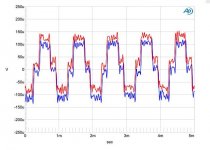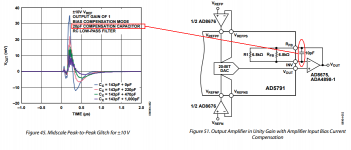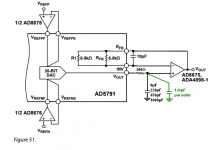Yes, the glitch energy is a problem for audio that we visited years ago. Samuel Groener helped a student do a de-glitcher for it that was impressive but it was shared under nondisclosure. I was hoping Weiss would make a product but I don't know if they did.
Last edited:
Schiit Yggdrasil - Best DAC available!? - Page 23 - DAC - Digital to Analog Conversion - Computer Audiophile
Search page for de-glitch.
Patrick
Search page for de-glitch.
Patrick
Search page for de-glitch.
No need to search it's everywhere, I assure you the one Samuel and his protege did was as good as it gets.
EDIT - that whole thread is a real Schiit storm.
Last edited:
Yes, the glitch energy is a problem for audio that we visited years ago.
DAC Essentials: What’s with all this glitch-ing? - Analog Wire - Blogs - TI E2E Community
Schitt's flagship DAC uses a not-for-audio DAC chip. - diyAudio
George
George just so you can appreciate by years ago I'm talking about day 1, we had two factions, on one side it was AD1856/62/65 and on the other side was a brilliant integrated Kelvin Varley voltage reference that needed serious de-glitching for audio. I made no friends in high places by saying the need for the de-glitcher is a kiss of death in a consumer socket. I was right in the end, no need to say the lines were drawn almost exactly along the Apple vs PC crew.
George just so you can appreciate by years ago I'm talking about day 1
Yes Scott, I noticed.
I went through most of the Head Fi thread.
I am not sure there is a consensus that the glitch is a real issue in listening tests.
By the way, where is this Cx connected that reduces the glitch ? (see Fig. 45)
http://www.analog.com/media/en/technical-documentation/data-sheets/AD5791.pdf
It is very interesting going through the data sheets of AD1865, AD5547 and AD5791 and notice the amount of measurement diagrams the data sheets of the newer DACs contain
George
as of the 21st century though, where is the delta-sigma boogy man? The measurements on the CD5004, with its now 14 year old cirrus chip in are superb. Attached image from Stereophile done on their AP shows an almost textbook undithered -90.31dB sine wave. I cannot see a parameter that needs to be bettered for CD playback and I also cannot see anything that the 30 year old 1543 could better in this application.
Attachments
By the way, where is this Cx connected that reduces the glitch ? (see Fig. 45)
I can only find a candidate in Fig. 51 as part of the bias compensation circuit.
as of the 21st century though, where is the delta-sigma boogy man? The measurements on the CD5004, with its now 14 year old cirrus chip in are superb. Attached image from Stereophile done on their AP shows an almost textbook undithered -90.31dB sine wave. I cannot see a parameter that needs to be bettered for CD playback and I also cannot see anything that the 30 year old 1543 could better in this application.
After you plug your CD80 back into your system, get back to us. I know that when I did, I was stunned.
I can only find a candidate in Fig. 51 as part of the bias compensation circuit.
That capacitor is already mentioned as 20pf in Fig 45.
The Cx maybe an internal capacitor set by the control register through programming. It is not mentioned anywhere, not in the evaluation board instructions, nor in the (accessible) programming info, nor at the Engineer Zone asked questions.
Space Search | EngineerZone
Maybe you can ask 🙂
George
Attachments
Maybe you can ask 🙂
George
I would have to ask but it looks like there is an internal 143pF and those add ons are standard values hung on some pin. Highly unlikely to have 1000pF on chip.
EDIT - see note 8 on page 4 of datasheet (still could use some clarification).
8 The AD5791 is configured in bias compensation mode with a low-pass RC filter on the output. R = 300 Ω, C = 143 pF.(total capacitance seen by the output buffer, lead
capacitance, and so forth).
EDIT EDIT - George I'll bet it's the standard high cap load drive circuit for op-amps, the 10pF goes directly from output but an R/C filter goes before the feedback via the resistor. The 143pF is the capacitance at that pin?
Last edited:
see note 8 on page 4 of datasheet (still could use some clarification).
EDIT EDIT - George I'll bet it's the standard high cap load drive circuit for op-amps
Very good Scott, I hadn’t seen it.
So what we see in Fig.45 is the result of Fig. 51 implementation with 6kOhm output clamp to ground (through control register programming) plus the hardware RC filter ? (see attachment for RC connection as I understand it)
The question is how Schiit guys have used the DAC (excluding the deglitching circuit).
Subquestions: with or without the output clamping, with or without a compensating capacitor, what compensating capacitor, with or without an RC filter, which RC filter, DAC connected per Fig. 51 or per Fig.53 ?
George
Attachments
Deglitching Techniques for High-Voltage R-2R DACs:
https://www.maximintegrated.com/en/app-notes/index.mvp/id/583
https://www.maximintegrated.com/en/app-notes/index.mvp/id/583
Somewhat off topic, but I am intrigued by de trade name 'Daniel Herz Levinson' that turned up with Mark's new products. When Mark Levinson sold his company way back, part of the deal was that he could no longer use his own name as a business trade name. So he started to do business as 'Daniel Herz', in, I kid you not, beauty products (well, marketing is marketing, right?).
Maybe his using 'Levinson' again has to do with the fact that Harman Kardon is discontinuing the Mark Levinson brand?
Jan
Maybe his using 'Levinson' again has to do with the fact that Harman Kardon is discontinuing the Mark Levinson brand?
Jan
An HP 4192A Impedance analyzer just dropped into my lap.... what should I measure re. audio?
5Hz to 13MHz. variable DC biasing for transistor and ceramic measurements vs dc and freq....etc
-RNM
5Hz to 13MHz. variable DC biasing for transistor and ceramic measurements vs dc and freq....etc
-RNM
Last edited:
Re listening,
Thank you Pavel
Thanks Tryphon for the link.Deglitching Techniques
Now the AD5971 shows glitch amplitude not that high (~30mV with no RC filter), very low power (1.4nVs) and with a very short rise time , I would say around 50ns (generated harmonics in the MHz range). Are artifacts audible?
The quoted Spurious Free Dynamic Range (DC to fs/2) is 100dB
George
I would like to reiterate that my rise-time 'standard' of 10 us with a 10KHz square wave has been nit-picked to leave confusion with people who actually want to know what might be necessary for best audio reproduction.
First of all, it is based on what has been possible, at least for the last 40 years, from analog circuitry, like 30ips recording, MC phono cartridges, and even some microphones. Of course, even faster rise-times are recordable with an analog instrumentation recorder at 120ips, but that is not very practical, is it?
I developed this criterion about 40 years ago, but have seen digital technology, cassette tapes, etc completely ignore this requirement, even up to today. You guys are going on about CD players, but NONE will ever even meet this criterion. This means, to me, that audio reproduction will always be 'compromised' just using CD's as a reference. However, hope is available! Just use 24-96K+ (96K, 192K, 384K) or SACD and at least this one 10us rise-time criterion can be achieved. So far, in my experience, it will take even more to achieve highest quality, but at least it is a milestone that has been achieved. Now, before further quibbling, why 10KHz? Why not 1KHz, 100Hz, even 10Hz? Of course, rise-time is separate from rep-rate, BUT a 10KHz square wave on an oscilloscope screen shows how the post filters actually compromise the waveform. 1KHz is OK, but less informing, and this is even more true with even lower frequency square waves, so let's stick with 10KHz, when possible.
It never ceases to amaze me that people think that CD can ever be 'perfect sound forever' with this fundamental limitation, but then there are alternatives, aren't there? Even with the same size disc and player.
Now, is this 'everything'? Of course not, but let us not ignore a simple measurement that needs to be met, and obscure our understanding with more complex criteria that might not be easily understood or even measured.
First of all, it is based on what has been possible, at least for the last 40 years, from analog circuitry, like 30ips recording, MC phono cartridges, and even some microphones. Of course, even faster rise-times are recordable with an analog instrumentation recorder at 120ips, but that is not very practical, is it?
I developed this criterion about 40 years ago, but have seen digital technology, cassette tapes, etc completely ignore this requirement, even up to today. You guys are going on about CD players, but NONE will ever even meet this criterion. This means, to me, that audio reproduction will always be 'compromised' just using CD's as a reference. However, hope is available! Just use 24-96K+ (96K, 192K, 384K) or SACD and at least this one 10us rise-time criterion can be achieved. So far, in my experience, it will take even more to achieve highest quality, but at least it is a milestone that has been achieved. Now, before further quibbling, why 10KHz? Why not 1KHz, 100Hz, even 10Hz? Of course, rise-time is separate from rep-rate, BUT a 10KHz square wave on an oscilloscope screen shows how the post filters actually compromise the waveform. 1KHz is OK, but less informing, and this is even more true with even lower frequency square waves, so let's stick with 10KHz, when possible.
It never ceases to amaze me that people think that CD can ever be 'perfect sound forever' with this fundamental limitation, but then there are alternatives, aren't there? Even with the same size disc and player.
Now, is this 'everything'? Of course not, but let us not ignore a simple measurement that needs to be met, and obscure our understanding with more complex criteria that might not be easily understood or even measured.
An HP 4192A Impedance analyzer just dropped into my lap.... what should I measure re. audio?
5Hz to 13MHz. variable DC biasing for transistor and ceramic measurements vs dc and freq....etc
-RNM
A QP?
//
- Status
- Not open for further replies.
- Home
- Member Areas
- The Lounge
- John Curl's Blowtorch preamplifier part II


